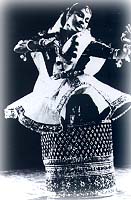Manipuri
Manipuri is the classical dance from the north East Indian state of Manipur. Its themes are devotional and are performed on religious occasions and in temples throughout the area. It is even often referred to as "sankirtan". The term Manipuri actually covers a number of dance forms from the region. The most important being the Ras Lila and the Pung Cholom.
History & Origin
 The history and development of Manipuri dance is interesting. It is said that King Khuyoi Tompok was a great patron of the arts and developed Manipuri in the 2nd century AD. However, it is not very likely that this early form of Manipuri had much in common with contemporary forms.
The history and development of Manipuri dance is interesting. It is said that King Khuyoi Tompok was a great patron of the arts and developed Manipuri in the 2nd century AD. However, it is not very likely that this early form of Manipuri had much in common with contemporary forms.
It is more likely that Manipuri began to take a familiar form with the introduction of Vaishnavism in the 15th century AD. This was first introduced by King Kyamba and greatly expanded under the support of later kings such as Khagemba, Chairairangaba and a host of others.
The earlier forms of Manipuri had not been codified or given a scientific base. This was accomplished in the 18th century by King Bhagyachandra. He invited the major teachers and performers from all over the area to codify their art into a coherent system.
There is a very characteristic style of music for Manipuri dance. The music is generally similar to the larger body of north Indian (Hindustani) music. However there are differences in nomenclature of rags, tals, and the style of presentation is somewhat different.
Performance & Features
Manipuri is unique among the classical Indian dances in that the instrumentation is a central part of the dance, rather than as a side accompaniment. Dances are very much based upon the cymbals (kartal or manjira) and the cylindrical drum known as Manipuri mridang or pung. Unlike other classical, dances where the instrument is merely used as an accompaniment, the pung and the kartal (manjira) are actually used in the dance. Other common instruments are the harmonium, pena, bansuri, shankh (conch), and esraj.
 The songs used in Manipuri are usually from the great poets of old such as Jaydev, Vidyapati, Chandidas, Govindadas or Gyandas. Any of a number of languages may be used such as Sanskrit, Maithili, Brijbhasha or others.
The songs used in Manipuri are usually from the great poets of old such as Jaydev, Vidyapati, Chandidas, Govindadas or Gyandas. Any of a number of languages may be used such as Sanskrit, Maithili, Brijbhasha or others.
There are a number of forms in Manipuri. These are the Ras Lila, the Pung Cholom, Nupa Cholom, Thoibi and a host of others. We will now look at them in greater detail.
The Ras Lila is the most important dance form in the Manipuri style. The theme revolves around the love of Krishna and the milkmaids (gopinis). Although the themes are romantic, we must remember that the Bhakti school of Hinduism considers physical love as a metaphor for spiritual longing. There are five Ras Lilas that deal with the divine love of Radha and Krishna. These are: Maharas, Vasantras, Kunjaras, Nityaras and Divaras. Other Ras deal with various aspects of Krishna's life such as Karnabheda (ear piercing), marriage, etc. The performance of Ras Lila is generally performed in a special enclosure in front of the temple called a Nat Mandap.
The Pung Cholom is a very characteristic dance of Manipur. It is based upon the drum known as pung or Manipuri mridang. This dance may be performed by men or women and is usually a prelude to the Ras Lila. In this style, the dancers play the pung at the same time that they are dancing. Sometimes acrobatics are used for an exciting effect, all without breaking the flow of the music.
 There are a number of other dance forms that make up the Manipuri tradition. The Nupa Pala is a variation of the Pung Cholom; this is also known as the Kartal Cholom and is the cymbal dance. There is the Khamba Thoibi; this portrays the love affair between a prince and princes of two warring clans. There is also the Maibi dance; this dance deals with the cosmogony of the Meitei people of Manipur.
There are a number of other dance forms that make up the Manipuri tradition. The Nupa Pala is a variation of the Pung Cholom; this is also known as the Kartal Cholom and is the cymbal dance. There is the Khamba Thoibi; this portrays the love affair between a prince and princes of two warring clans. There is also the Maibi dance; this dance deals with the cosmogony of the Meitei people of Manipur.
Today, Manipuri is generally acknowledge as a classical dance form of very high artistic and technical standards.
Manipuri is one of the most beautiful dance styles of India. Nurtured in the mountainous region of the northeast, it takes its name from the name of the area, Manipur, which is now a state. Manipur literally means a jewel of a land, and the state is set like a gem in the verdant hills. The legend goes that the gods drained a lake in the beautiful countryside in order to find a place to dance. No wonder then, that dance is an inherent part of the rituals of daily life, such as weddings and homage to ancestors.
The Lai Haroba, a ritualistic dance depicting the Creation, is considered the precursor of Manipuri as seen today. The Lai Haroba is still an important living tradition, while Manipuri has expanded and gained popularity as a performing art in group and solo presentations.
- More Dances: Bharatnatyam | Kathak | Kuchipudi | Manipuri | Mohiniattam | Kathakali | Odissi
